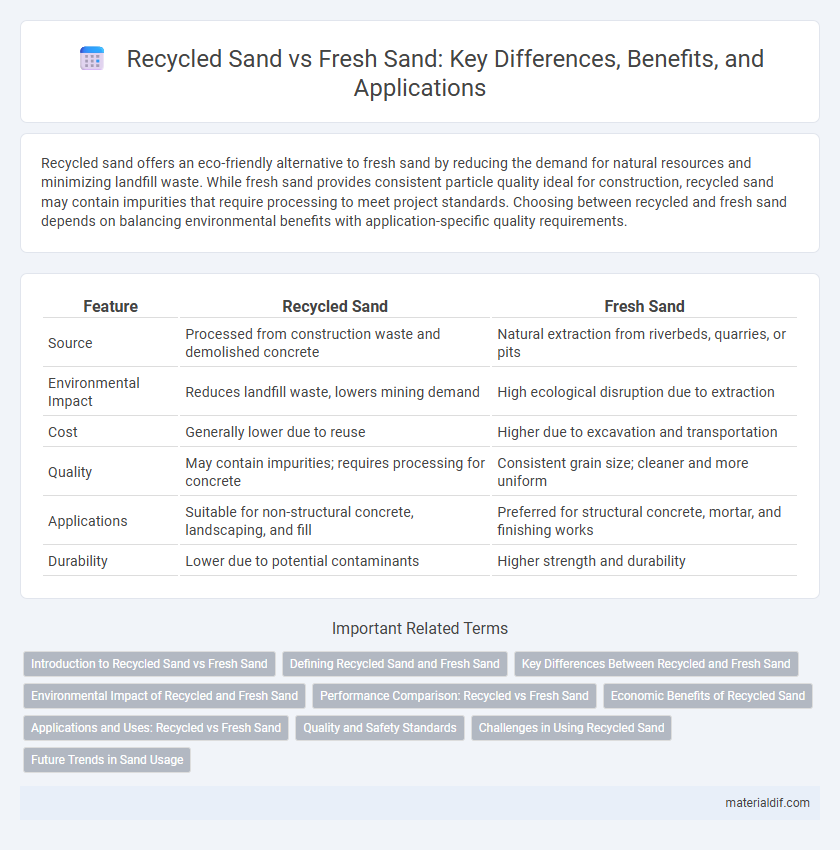Recycled sand offers an eco-friendly alternative to fresh sand by reducing the demand for natural resources and minimizing landfill waste. While fresh sand provides consistent particle quality ideal for construction, recycled sand may contain impurities that require processing to meet project standards. Choosing between recycled and fresh sand depends on balancing environmental benefits with application-specific quality requirements.
Table of Comparison
| Feature | Recycled Sand | Fresh Sand |
|---|---|---|
| Source | Processed from construction waste and demolished concrete | Natural extraction from riverbeds, quarries, or pits |
| Environmental Impact | Reduces landfill waste, lowers mining demand | High ecological disruption due to extraction |
| Cost | Generally lower due to reuse | Higher due to excavation and transportation |
| Quality | May contain impurities; requires processing for concrete | Consistent grain size; cleaner and more uniform |
| Applications | Suitable for non-structural concrete, landscaping, and fill | Preferred for structural concrete, mortar, and finishing works |
| Durability | Lower due to potential contaminants | Higher strength and durability |
Introduction to Recycled Sand vs Fresh Sand
Recycled sand is produced by processing construction and demolition waste, reducing environmental impact by minimizing natural sand extraction. Fresh sand, also known as natural sand, is mined directly from riverbeds, quarries, or beaches, offering consistent grain size and purity but depleting natural resources. The choice between recycled and fresh sand depends on project requirements, sustainability goals, and local availability.
Defining Recycled Sand and Fresh Sand
Recycled sand is produced by processing construction and demolition waste, such as crushed concrete, bricks, and other materials, to create a sustainable alternative to natural sand. Fresh sand, also known as natural or river sand, is mined directly from riverbeds, dunes, or beaches and typically exhibits finer granules and higher purity. Understanding the composition and environmental impact of recycled sand versus fresh sand is essential for optimizing resources in construction and reducing ecological footprints.
Key Differences Between Recycled and Fresh Sand
Recycled sand is produced by crushing and processing construction and demolition waste, resulting in a material with higher porosity and often containing impurities like dust and wood particles, whereas fresh sand is naturally sourced from riverbeds or quarries and features uniform grain size and cleanliness. The density of fresh sand generally exceeds that of recycled sand, affecting its compaction and strength in concrete mixes. Recycled sand offers sustainability advantages by reducing landfill waste and conserving natural resources, but it may require additional treatment to match the performance of fresh sand in high-strength applications.
Environmental Impact of Recycled and Fresh Sand
Recycled sand significantly reduces the environmental impact by minimizing the extraction of natural resources and decreasing landfill waste. Fresh sand mining contributes to habitat destruction, groundwater depletion, and increased carbon emissions due to heavy machinery use. Choosing recycled sand supports sustainable construction practices and helps preserve ecosystems affected by conventional sand extraction.
Performance Comparison: Recycled vs Fresh Sand
Recycled sand exhibits comparable compressive strength and durability to fresh sand in concrete mixtures when properly processed, making it a viable alternative for sustainable construction. Its particle size distribution and angularity often enhance bonding with cement paste, improving mechanical performance in certain applications. However, fresh sand typically offers more consistent quality and fewer impurities, which can result in more reliable long-term performance in structural elements.
Economic Benefits of Recycled Sand
Recycled sand offers significant economic benefits by reducing costs associated with raw material extraction and transportation, which can account for up to 30% of total project expenses. Utilizing recycled sand minimizes landfill fees and promotes sustainable waste management, leading to long-term savings for construction and manufacturing industries. The consistent availability of recycled sand also stabilizes supply chains, preventing price volatility common with fresh sand extraction.
Applications and Uses: Recycled vs Fresh Sand
Recycled sand is primarily used in non-structural applications such as landscaping, road base, and concrete blocks, offering an eco-friendly alternative to fresh sand. Fresh sand remains the preferred choice for high-strength concrete, masonry, and fine finishing due to its consistent particle size and purity. Choosing between recycled and fresh sand depends on the specific requirements of durability, cost-effectiveness, and environmental impact in construction projects.
Quality and Safety Standards
Recycled sand undergoes rigorous processing to meet stringent quality and safety standards, often achieving comparable particle size distribution and cleanliness to fresh sand. It reduces environmental impact by minimizing natural resource extraction while maintaining structural integrity in construction applications. Quality controls ensure contaminants like organics, clay, and silt are removed, safeguarding durability and compliance with building regulations.
Challenges in Using Recycled Sand
Recycled sand often presents challenges such as inconsistent grain size, higher moisture content, and elevated levels of contaminants like clay and silt, which can adversely affect concrete strength and durability. Processing recycled sand to meet construction standards requires advanced treatment techniques that increase production costs and complexity. These issues limit its widespread adoption despite environmental benefits, necessitating further research to optimize quality and reliability.
Future Trends in Sand Usage
Recycled sand is gaining traction as sustainable construction practices increase, driven by depleting natural sand reserves and environmental regulations limiting river sand extraction. Advances in processing technologies improve the quality and consistency of recycled sand, making it more competitive with fresh sand in concrete and masonry applications. Future trends indicate a growing market share for recycled sand, supported by circular economy initiatives and urban mining projects aimed at reducing extraction-related ecological impacts.
Recycled Sand vs Fresh Sand Infographic

 materialdif.com
materialdif.com